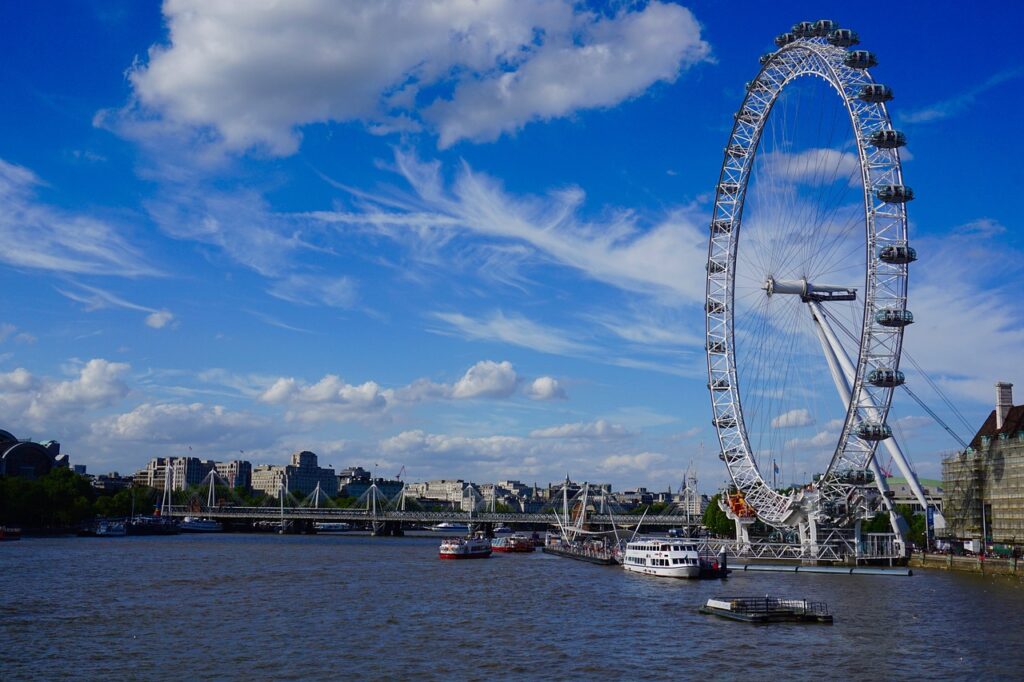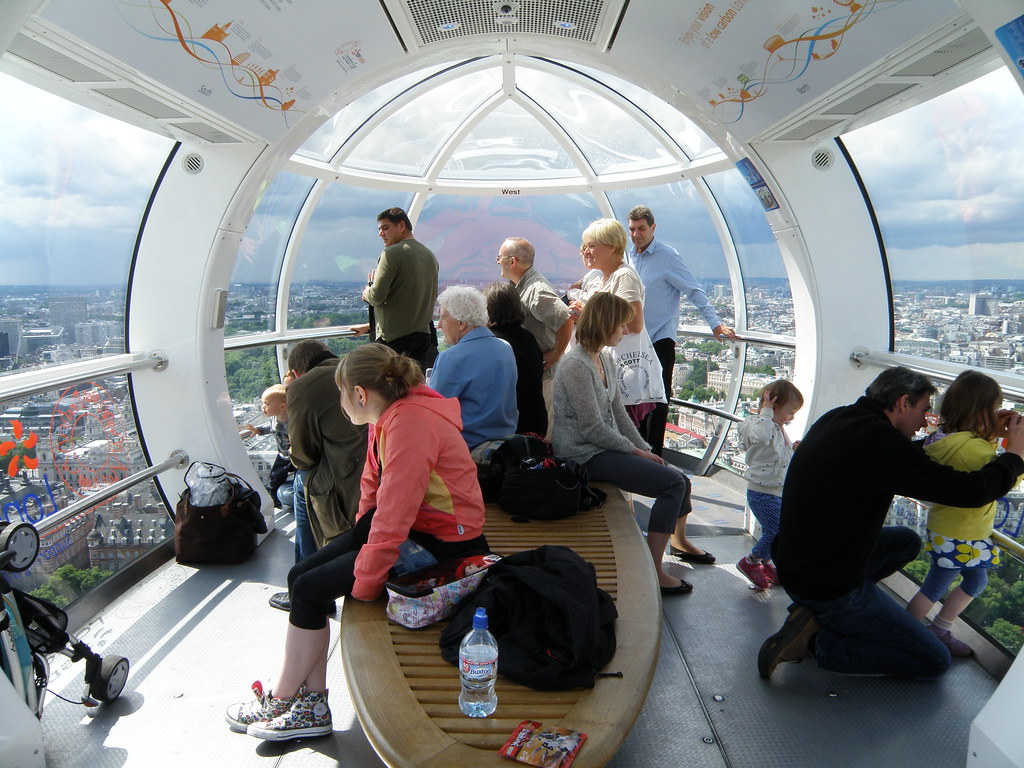The London Eye, standing tall at 135 meters (443 feet), is one of the most popular tourist attractions in the United Kingdom. This giant Ferris wheel, situated on the South Bank of the River Thames, offers breathtaking views of the city’s skyline. Since its opening in 2000, it has attracted over 60 million visitors from around the world. In this article, we will dive deep into the history of the London Eye, the tourist experience, how to get there, what to pack, ticket pricing, and the best time to visit this iconic landmark.

Table of Contents
ToggleHistorical Data and Important Dates
- Planning and Construction: The idea for the London Eye was born in 1993 as part of a competition organized by The Sunday Times and the Architecture Foundation to design a landmark for the new millennium. Architects David Marks and Julia Barfield submitted the winning proposal, which was selected in 1994. Construction began in 1998, with the wheel being assembled horizontally before being raised into its vertical position.
- Opening: The London Eye officially opened to the public on March 9, 2000. Initially, it was planned to be a temporary installation for five years, but due to its overwhelming popularity, it has remained a permanent fixture in London.
- Ownership and Naming: The London Eye has gone through various ownership changes and name alterations over the years. Initially, it was known as the Millennium Wheel. Later, it was called the British Airways London Eye, followed by the Merlin Entertainments London Eye. Since January 2011, it has been known as the EDF Energy London Eye and later the Coca-Cola London Eye. Presently, it is simply called the London Eye.

Tourist Attractions and Experience
- The Capsules: The London Eye features 32 glass capsules, each representing one of London’s boroughs. Each air-conditioned capsule can accommodate up to 25 people, offering 360-degree panoramic views of the city. The rotation of the wheel takes approximately 30 minutes to complete.
- Views from the Top: On a clear day, visitors can see up to 25 miles (40 kilometers) from the top of the London Eye. Some of the most iconic landmarks visible include the Houses of Parliament, Buckingham Palace, St. Paul’s Cathedral, and the Tower of London.
- London Eye 4D Cinema Experience: Included in the ticket price is a 4D cinema experience. This immersive, multi-sensory journey showcases a 3D film of London with in-theater effects such as wind, bubbles, and scents.
- Special Events and Experiences: Throughout the year, the London Eye hosts various special events such as Valentine’s Day packages, New Year’s Eve celebrations, and the London Eye River Cruise.
How to Get to the London Eye
The London Eye is located at the following address: Lambeth London SE1 7PB
Public transportation options include:
- Tube: The nearest tube station is Waterloo (Jubilee, Northern, Bakerloo, and Waterloo & City lines), which is a 5-minute walk away. Other nearby stations include Embankment (Circle, District, Northern, and Bakerloo lines) and Charing Cross (Bakerloo and Northern lines).
- Train: The nearest train station is London Waterloo, a 5-minute walk from the London Eye.
- Bus: Various bus routes pass close to the London Eye, including routes 211, 77, and 381.
- River: Thames Clippers operate river bus services to the London Eye Pier.
What to Pack in Your Bag For a Good Tourist Experience
- A lightweight, water-resistant jacket: London’s weather can be unpredictable, so it’s a good idea to have a jacket that can protect you from rain and wind.
- Comfortable walking shoes: You’ll likely be doing a lot of walking while exploring London, so make sure to pack a pair of comfortable shoes.
- Camera or smartphone: Capture the stunning views from the top of the London Eye and other iconic sights throughout your visit.
- Water bottle: Stay hydrated during your sightseeing adventures, especially during the warmer months.
- A small backpack or bag: Carry essentials like your wallet, tickets, sunscreen, and a travel guide or map.
- Umbrella: An essential item for London’s unpredictable weather.
The London Eye Ticket Pricing
- Standard Tickets: The cost of a standard adult ticket for the London Eye is £27.50 when purchased on the day, or £24.75 when booked online in advance. Child tickets (ages 3-15) are priced at £22.00 on the day and £19.80 online in advance. Children under 3 can enter for free.
- Fast Track Tickets: These tickets allow you to skip the main queue and join the Fast Track queue. Fast Track adult tickets cost £37.50, and Fast Track child tickets are £32.00.
- Combination Tickets: Save money by purchasing combination tickets for the London Eye and other attractions such as SEA LIFE London, the London Dungeon, or Madame Tussauds.
- Annual Passes: Merlin Annual Passes offer unlimited access to the London Eye and other top UK attractions for a full year.
Best Time of the Year to Visit
- Spring (March-May): Spring is a great time to visit the London Eye, with relatively mild weather and blossoming trees and flowers throughout the city. Keep in mind that the Easter holidays can be crowded.
- Summer (June-August): The summer months offer the warmest weather and longer daylight hours, but also attract the largest crowds. To avoid long queues, consider booking Fast Track tickets or visiting early in the morning or late in the evening.
- Autumn (September-November): Autumn brings cooler temperatures and beautiful fall foliage, making it a pleasant time to visit. However, daylight hours are shorter, so plan accordingly.
- Winter (December-February): The winter months are the least crowded, but the weather can be cold, wet, and windy. The London Eye is also closed on Christmas Day. Despite the weather, the festive atmosphere and holiday decorations make it a magical time to visit.
Conclusion
The London Eye is a must-see attraction for anyone visiting London, offering unparalleled views of the city’s most iconic landmarks. With its rich history and a variety of experiences to enjoy, it’s no wonder this remarkable structure has become synonymous with the London skyline. Be sure to plan your visit, pack the essentials, and enjoy the unforgettable experience of seeing London from above.
With an insatiable curiosity and a keen eye for detail, she has since traversed the nooks and crannies of London, uncovering stories that have shaped the world.
Her love for history is not just confined to books; she believes in experiencing it firsthand. This led her to embark on numerous tours, with the Tower of London being one of her favorites.
- Journey Through Time: Stonehenge and Windsor Castle Tour - September 11, 2023
- The UK Merlin Annual Pass: A Comprehensive Guide - August 7, 2023
- 10 Prominent People Buried at Westminster Abbey - August 7, 2023

